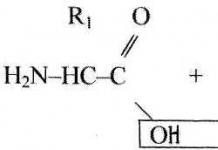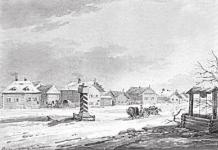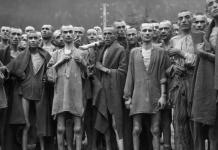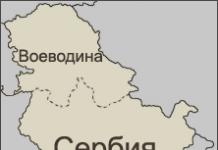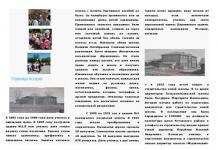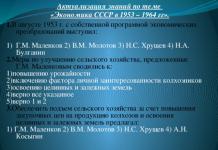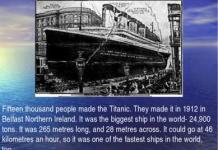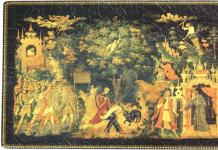The U. process became the subject of research in the USSR in the 1920s. (surveys of migration, life and recreation of various social groups, etc.). This stage is marked by discussions between "urbanists" and "de-urbanists". However, during this period, U. was not yet identified to the necessary extent, technics were absolutized. sides of the process, which sometimes amounted to industrialization. The deepening of the study of W. is associated with the development of sociological. research since the late 1950s. The importance of U. in the development of society is shown, its consideration as an integral phenomenon in connection with the tasks of social management and planning.
Lit.: K. Marx and F. Engels, Soch., 2nd ed., vol. 46, part 1; Weber A., The growth of cities in the 19th century, trans. from English, St. Petersburg, 1903; Bucher K., Large cities in the past and present, trans. from German, St. Petersburg, 1905; Weber M., City, [transl. from German], St. Petersburg, 1923; Okhitovich M., On the problem of the city, "Modern architecture", 1929, No4; Sabsovich L. M., New ways in the construction of cities, "Construction of Moscow", 1930, No 1; Pchelintsev O. S., Rational placement of production and the problem big cities, "VF", 1961, No 2; Urlanis B. Ts., Fertility and life expectancy in the USSR, M., 1963; Pokshishevsky VV, On the study of urbanization in developing countries and related ethn. processes, M., 1964; Kogan L. B., Loktev V. I., Some sociological. aspects of urban modeling, "VF", 1964, No 9; Sjoberg G., Comparative Urbanist, in: Sociology Today, trans. from English, M., 1965; Geography of cities. Sat. st., trans. from English, M., 1965; Sociological problems of the Polish city, trans. from Polish., M., 1966; Yanitsky O.N., Concrete sociological. research in urban planning, "Architecture of the USSR", 1967, No 2; Kogan L., Urbanization - - microdistrict, "Architecture of the USSR", 1967, No 4; Akhiezer A. S., Some questions of the methodology of urban planning science, "Architecture of the USSR", 1968, No 2; Akhiezer A. S. Kogan L. B., Yanitsky O. N., Urbanization, and scientific and agricultural. revolution, "VF", 1969, No 2; Listengurt Φ. Μ., Perspective changes in the mountains. of the population in the USSR, "Izv. AN SSSR. Geographic Series", 1969, No 1; Scientific forecasts of development and formation of owls. cities on the basis of social and scientific and technical. progress, vol. 1–3, M., 1968–69; Park R. E., Burgess E. W., Mac Κenzie R. D., The city, Chi., 1925; Mumford L., The culture of cities, L., 1938; Cities and society, Glencoe (Ill.), 1957; Le phénomène de l "urbanisation en Asie et en Extrême-Orient, Cale, 1959; Famille et habitation, t. 1–2, P., 1963; Dumazedier J., Contenu culturel du loisir ouvrier dans six villes d" Europe, " Revue française de sociology", 1963, v. 4, no 1; Hauser P. M., Schnore L. F., The study of urbanization, N. Y., 1965; Przecławski K., Miasto i człowiek, (bibl.); Wallis A., Socjologia wielkiegomiasta, Warsz., 1967. See also lit. at Art. Opposite between city and countryside.
L. Kogan. Moscow.
Philosophical Encyclopedia. In 5 volumes - M .: Soviet Encyclopedia. Edited by F. V. Konstantinov. 1960-1970 .
URBANIZATION (from Latin urbanus - urban, urbs - city) - the historical process of increasing the role of cities in the development of society, causing changes in the socio-professional and demographic structure of the population, influencing its culture, lifestyle, psychology, etc. Main an indicator of urbanization is an increase in the proportion of the urban population.
The first urban-type settlements arose in 3-1 thousand BC. e. in Mesopotamia, Egypt, Syria, India, M. Asia, China. They arose as centers of crafts and trade, strongholds of defense against external enemies, centers of power and administration, service and culture. Almost all ancient cities were located in river valleys, which created favorable conditions to develop trade and cultural ties with other peoples.
The ancient cities reached their greatest prosperity during the Roman era - they were built and expanded throughout the territory from Britain to modern Iraq, they built stately public buildings and improved water supply and sewerage systems.
Cities had a great impact on the life of medieval society. They stimulated the creation of centralized states, contributed to the development of commodity-money relations. In 16-17VV. many large cities were originally founded as ports: Boston, Cape Town, Bombay, Rio de Janeiro, New York. They served as central points for the distribution of goods and became centers of colonial administration.
The process of industrialization had a huge impact on the development of cities. The development of industry and the trend of its concentration in cities contributed to migration a large number villagers to urban centers in search of higher paying jobs. Three British cities - Manchester, Leeds and Birmingham - are classic examples of cities whose development has led to the growth of industry. The population of Manchester, the main center for the production of cotton fabrics in the country, increased by 22% from 1801 to 1811, by 40% from 1811 to 1821, and by 47% from 1821 to 1831, amounting to almost 228 thousand by 1831.
The intensification of the process of urbanization led in the 19th century. to the so-called. urban revolution, an increase in the concentration of a significant part of the population in cities, which became possible due to the development of industry, transport and communications, the intensification of agricultural production, the improvement of knowledge in the field of medicine, etc. The share of the urban population in the world during the period from 1800 to 1990 increased from 5.1 to 41.3%.
Urbanization was due to the need for spatial concentration and integration of various forms and types of spiritual and material activities of people, the strengthening of ties between various spheres of production, science and culture, which in turn stimulated the intensification of various social processes.
The process of urbanization has two phases. In the first phase, the concentration and accumulation of the cultural and economic potential of society in large cities takes place. Then, in the second phase, patterns of material and spiritual activity of urban centers are mastered by other, non-central cities and rural settlements, which gives impetus to the further development of the main centers.
The movement from the center to the periphery is effective only when the urban principle in social phenomena “inculcates” certain universal features in all cities. At the same time, each urban community has its own historical, regional, cultural and other features. Thus, the two-pronged urbanization is permeated with interaction and mutual enrichment of central and peripheral patterns of activity, culture, and behavior. The process of interaction between urban communities is essential foundation formation of national goals and interests.
The development of the urbanization process created the conditions for the emergence of the so-called. urban consciousness, which has become an integral part of personality development. The ability to harmonize and integrate the interests, goals and needs of various social strata, groups, organizations, tastes and preferences of hundreds of thousands and millions of people makes cities an essential element of a modern democratic society.
In the process of urbanization, an urban lifestyle is formed, which becomes an integral part of urban culture. It is characterized by special communication, a certain specificity of personality development, intra-group relations, etc. One of the signs of the urban lifestyle is the psychological mobility of a person, which in the conditions of the city manifests itself as a desire for constant updating of social information, intensification of contacts in various spheres of public and personal life, readiness to change the social environment and spatial localization.
Increasing urbanization has led to serious social and environmental problems, such as air and water pollution, waste disposal, density and development, transportation, energy consumption, harmful effects of noise, uneven development of central and peripheral cities, etc. There are also economic difficulties, for example . the problem of exorbitantly rising costs while reducing incomes, which the authorities of many modern cities face. The migration of people with middle and high incomes, as well as businesses to the suburbs, has been one of the reasons for the reduction in tax revenues and rising unemployment in cities.
A new trend in modern urbanization is the construction of improved quality residential buildings for high-income families inside the city. This leads to an increase in the cost of land in the city center or in certain areas that become inaccessible to the less affluent segments of the population, which is the reason for the division of the city into "poor" and "rich" areas.
The current stage of urbanization is characterized not only by its “pointy” form, i.e., the concentration of the population in large cities (over 100 thousand people), but also by the agglomerative form. Around the largest urban centers, a cluster of settlements is formed, mostly of an urban type, merging into a single one as a result of the intensification of economic and cultural ties. Some modern agglomerates extend for several hundred kilometers.
The scientific and technological revolution, the increasing importance of various social information (scientific, technical, cultural, etc.), the need to deepen the links between various fields of knowledge and activity have led to an increase in the concentration of the population in the largest urban centers. A special role in expanding the scope of urbanization is played by the development of means of communication, transport and mass communication, which contribute to the familiarization of residents of peripheral areas with the values and lifestyle of the population of large cities.
The main achievements of civilization are undoubtedly associated with the process of urbanization. The development of cities contributed to the growth of the welfare of society, the development of culture, and the increase in the diversity of social life. In the same time
The first factor
affecting
- influence environment. Half of the world's population lives in the lowlands, 1/3 - in coastal areas. Most of the population lives along the river banks. People inhabit areas with a favorable climate. Therefore, the most populous states are in the subtropical and subequatorial climate, as well as in the temperate south. Second factor
- economic. The presence of resources (land, forest, minerals, etc.) has always attracted people, this explains the development of lowlands by people. Third factor
The rural population in the world has traditionally been larger, but in the 21st century the population of villages and cities has leveled off. (3.4 billion rural and 3.4 billion urban) By 2050, a significant increase in the urban population is expected. At the same time, citizens occupy only 3% of the land surface. The global effect of urbanization has become most noticeable in the economically developed regions of the world. Thus, the level of urbanization has already exceeded 80% in Australia, New Zealand, North America, and Europe.
Among the less developed regions, an extremely high level of urbanization (78%) has been achieved in Latin America and the Caribbean. In contrast, Africa and Asia have urban proportions of 38% and 41%, respectively. Urbanization is expected to increase in all major areas over the next decade, with Africa and Asia accelerating faster. The urban population is highly concentrated in a limited number of countries. In 2007, three-quarters of the world's 3.3 billion urban dwellers lived in 25 countries, with urban populations ranging from 29 million in South Africa to 561 million in China. The top three countries with the most urban dwellers are: . Today, 35% of the world's urban population lives in these states. Russia is also in the list of 25 countries.
agglomerations Megalopolis is a horizontal line of large and small cities merged into a single line. Linearity is one of distinguishing features megalopolis from megalopolis. Currently, there is a phenomenon suburbanization . This is the relocation of part of the wealthy population to the suburbs. For example: Rublevskoe highway in Moscow. Population density is closely related to urbanization. The world average is 40 people. per km2. But basically, the entire population of the land is located on 7% of the area of \u200b\u200bthe continents. 90% of the population lives in the Northern and Eastern Hemispheres. Migration has become a common phenomenon in the modern world. Migration is a population shift. The departure of people from their country for permanent residence is called emigration, the entry is called immigration. Since 2013, the natural disaster for the European Union has been the process of migration of people from Asia and Africa to European countries. According to official estimates, since January 2015, 1.2 million people have applied for asylum in the EU countries. The unprecedented influx of migrants has become a serious burden for many EU countries. Until the end of 2016, a new wave of emigration up to 3 million people is expected. This is more than the population of Lithuania, Slovenia, Latvia, Estonia, Cyprus, Luxembourg or Malta. The burden of receiving and servicing migrants is distributed differently among the EU countries. The most serious falls on Germany, France and Sweden. People want to go to Germany, because it is a democratic country with a strong economy, a country where the role of both Christianity and religious freedom is strong, and in which you can get both a good education and related medical care. The main motive of migrants when moving is to find a place to apply their labor. These migrations are called labor migrations. In the 19th century, from many backward countries came "muscle drain" "brain drain"

VIEW MORE:
Rates of urban population development. concentration of population in big cities. Creation of urban agglomerations. Megacities as the highest link in the process of urbanization. The main factors of urbanization. Manifestation of urbanization in cities, its negative impacts.
Students, graduate students, young scientists who use the knowledge base in their studies and work will be very grateful to you.
The process and scale of global urbanization
World features of the process of urbanization.
Quantifying the impact of the concentration of economic activity in cities on productivity in the regions of the country. Features of urbanization in modern Russia.
Urban and rural population. Urbanization
Components of urban population change.
term paper, added 11/28/2014
Urbanization. Cities of the world
Urbanization as a process based on the growth of cities and urban populations in all regions of the world. History of cities. Urban agglomerations and megalopolises. Rates and levels of urbanization.
Transition from a "point" city to urban agglomerations.
presentation, added 05/15/2013
Urban Development in the 21st Century
Definition of the city. Essence of urbanization and indicators of urbanization of the population of the Earth. Brief history and perspectives of urbanization. First steps in solving the problem of urban development in the future. Organization of effective environmental monitoring.
test, added 05/10/2009
Urbanization as a global process
The concept of urbanization, its essence and features, the history of origin and development, the current state.
The main reasons and prerequisites for the increase in the share of citizens in the state, the nature of urbanization in developing countries and the peculiarities of its course in Russia.
abstract, added 03/31/2009
Urbanization and its role in the life of society. Human socialization
The concept of urbanization, its role in society. Humanistic approach to the interpretation of socialization. Levels, rates and prospects of urbanization.
The concept of socialization. The city as a mesocomponent of the human socialization environment. Level analysis of factors of socialization.
abstract, added 10/10/2008
Family life cycle. Factors of urbanization
Demographic forecasts for Russia. The concept of the family life cycle: the history of formation and methodological possibilities. The main factors of urbanization. Phases of the family life cycle according to Duval. Theory of social mobility. Dynamics of family roles.
abstract, added 09/27/2012
Urbanization: ideas and reality
Concept of urbanization and city.
Urbanization process, its causes, properties and features in the context of urban formations. Public housing for the poor in the United States. Problems of social housing complexes on the example of the quarter "Pruyt-Igou" in St. Louis.
abstract, added 12/26/2014
Migration: essence and phenomenon
Migration of the population as the movement of the population associated with a change of residence. Causes, types, types of migration flows in the Russian Federation. Impact of urbanization on internal migration.
Main sources of migration control. Types of international migration of the population.
presentation, added 03/06/2011
Sociology of the city
Acquaintance with the history of the development of urban sociology as an independent branch of knowledge.
Consideration of a number of socio-historical conditions of urbanization and their modern content; study of problems in this area.
Sociology of urban lifestyle.
term paper, added 06/08/2014
Features of communication in the city
Language as the main means of communication modern city. Factors influencing the formation of the speech of the inhabitants of the metropolis. Analysis of the impact of urbanization on the specifics of urban communication. The role of mass information communications in the life of a modern city.
abstract, added 08/19/2010
115. Megalopolises of the USA
Another one essential feature process of urbanization in the United States is formation of megalopolises- vast urbanized zones of a strip-like configuration, which are formed as a result of the actual merging of many neighboring agglomerations of different ranks. Typically, such urbanized lanes stretch along the most important transport routes and multi-highways, or a kind of economic axes.
The United States can be called the birthplace of megalopolises.
It was here that the Northeastern, Lakeside and California megalopolises were formed and studied. General view Table 59 gives about each of them.
The oldest and most studied of them is the Northeastern (Atlantic) megalopolis. The well-known geographer Jean Gottmann, who borrowed this name from Ancient Greece, called this urbanized strip a megalopolis. At the extreme points of its strike, it is also called the Boswash megalopolis, i.e.
e. Boston - Washington (Fig. 180). It included the CMSAs of Boston, New York, Philadelphia and dozens of PMSAs. The core of the Lakeside megalopolis, often referred to as the Chipits (Chicago-Pittsburgh), are the CMSAs of Chicago, Detroit, Cleveland, and also dozens of PMSAs.
And in the California megalopolis e, also called Sansan (San Francisco - San Diego), the CMSA of San Francisco and Los Angeles stand out.
Scientific forecasts For quite a long time, they began to proceed from the fact that, firstly, there should be an expansion of the three named megalopolises and, secondly, the formation of new ones in other parts of the country is quite likely.
Now with full confidence it can be argued that such forecasts came true (Fig. 181).
§ 66. URBANIZATION
This figure shows that the Northeast megalopolis has moved significantly to the south, the Lakeside megalopolis to the northeast, and the California megalopolis to both the north and south. In addition, in general terms, three new megalopolises have formed - on the coasts of Florida, the Gulf of Mexico and the Pacific Ocean. It is noteworthy that the two megalopolises have actually become international, since they are located within both the United States and Canada.
Table 418
US MEGALOCITIES

It is not necessary to imagine a megalopolis as a zone of continuous urban development.
On the contrary, such development usually occupies only a very small part (about 1/10) of its entire territory, while the rest of the space is occupied by cottages, fields, forests, transport routes, reservoirs, free land.
Urbanization is a global process
The main economic force in the world economy is labor resources. The first factor affecting formation of a labor resource — the influence of the environment. Half of the world's population lives in the lowlands, 1/3 - in coastal areas. Most of the population lives along the river banks. People inhabit areas with a favorable climate.
Therefore, the most populous states are in the subtropical and subequatorial climate, as well as in the temperate south. Second factor - economic.
The presence of resources (land, forest, minerals, etc.) has always attracted people, this explains the development of lowlands by people. Third factor - employment. In industrial areas, there is a significantly larger population than in others with similar conditions. The main form of accommodation of the population people in the modern world are gradually becoming cities. Urbanization is the process of growth of cities and urban population, the strengthening of their economic role, the widespread urban lifestyle. The rural population in the world traditionally has more, but in the 21st century the population of villages and cities has leveled off (3.4 billion people).
rural and 3.4 billion urban) By 2050, a significant increase in the urban population is expected. At the same time, citizens occupy only 3% of the land surface. The global effect of urbanization has become most noticeable in the economically developed regions of the world.
Thus, the level of urbanization has already exceeded 80% in Australia, New Zealand, North America, and Europe.
Among the less developed regions, an extremely high level of urbanization (78%) has been achieved in Latin America and the Caribbean. In contrast, Africa and Asia have urban proportions of 38% and 41%, respectively. Urbanization is expected to increase in all major areas over the next decade, with Africa and Asia accelerating faster.
Urbanization
The urban population is highly concentrated in a limited number of countries. In 2007, three-quarters of the world's 3.3 billion urban dwellers lived in 25 countries with an urban population of 29 million or more.
people in South Africa to 561 million people in China. The top three countries with the most urban dwellers are: China, India and the United States of America. Today, 35% of the world's urban population lives in these states.
Russia is also in the list of 25 countries. GIANT CITIES (unofficial data for 2015 from an unknown source)
Urbanization is closely related to the concept of huge cities. Satellites of large cities form agglomerations . Megalopolises have become the highest link in the process of urbanization. Megalopolis is a horizontal line of large and small cities merged into a single line.
Linearity is one of the distinguishing features of a megalopolis from a megalopolis. Currently, there is a phenomenon suburbanization . This is the relocation of part of the wealthy population to the suburbs. For example: Rublevskoe highway in Moscow.
Population density is closely related to urbanization. The world average is 40 people. per km2. But basically, the entire population of the land is located on 7% of the area of \u200b\u200bthe continents. 90% of the population lives in the Northern and Eastern Hemispheres. Migration has become a common phenomenon in the modern world. Migration is a population shift.
The departure of people from their country for permanent residence is called emigration, the entry is called immigration. Since 2013, the natural disaster for the European Union has been the process of migration of people from Asia and Africa to European countries. According to official estimates, since January 2015, 1.2 million people have applied for asylum in the EU countries. The unprecedented influx of migrants has become a serious burden for many EU countries. Until the end of 2016, a new wave of emigration up to 3 million people is expected.
This is more than the population of Lithuania, Slovenia, Latvia, Estonia, Cyprus, Luxembourg or Malta. The burden of receiving and servicing migrants is distributed differently among the EU countries. The most serious falls on Germany, France and Sweden. People want to go to Germany because it is a democratic country with a strong economy, a country where the role of both Christianity and religious freedom is strong, and where you can get both a good education and appropriate medical care.
The main motive of migrants when moving is to find a place to apply their labor. These migrations are called labor migrations. In the 19th century, from many backward countries came "muscle drain" in a post-industrial society "brain drain"

VIEW MORE:
Lecture Search
Importance of urbanization in modern society
Urbanization in a broad sense is a multifaceted socio-economic, demographic and geographical process of increasing the role of cities in the development of society. In a narrow sense, this is the growth of cities, mainly large ones, an increase specific gravity urban population.
Modern urbanization occurs not only due to the classical scheme characteristic of past centuries, that is, due to visiting rural residents and foreigners.
Of particular importance are such factors as the transformation of rural settlements into urban areas and the formation of large-scale suburban areas that have all the features of a city.
The consequence of this was the so-called suburbanization. This is the emergence of urban agglomerations (megacities), that is, territorial groupings of urban and rural settlements that form a vast zone of continuous development. In fact, they are "super-cities" and consist of a core and periphery.
The core of the agglomerations are mainly the capitals of states, important industrial centers. The population of such a sprawling city may be a significant proportion of the inhabitants of the entire country. The first signs of suburbanization began to appear before the Second World War, as a form of flight of the wealthy from social diseases. big city.
Currently, about 25 large urban agglomerations with a population of over 10 million have formed on the planet.
people These are Sao Paulo and Rio de Janeiro, Tokyo, New York, Shanghai and Beijing, Bombay, Jakarta. The largest city in the world is Mexico City (25.8 million people). In our country, the Moscow agglomeration stands out, consisting of hundreds of urban and several hundred rural settlements.
Urbanization reaches its highest degree in megalopolises (the merger of several largest megalopolises), where you can get from city to city without leaving the city limits.
These formations include Boswash (Boston - Washington), Tokaido (Tokyo - Osaka - Nagoya), California megalopolis, Rhine megalopolis, English megalopolis with cores - London and Liverpool agglomerations.
Modern cities occupy 1% of the land area, but they contain half of the world's population and most of the industry.
In the early 90s. In the twentieth century, the level of urbanization in developed countries was about 72%, in developing countries - 33%. Now the situation is rapidly changing. As communication technologies improve and investment in human capital increases, the growth of large cities in developing countries will continue.
According to the level of urbanization, the countries of the world are divided into two groups: highly urbanized with a share of the urban population above 50% (North America, Australia, most countries of Western Europe, Japan, Russia, Ukraine, Belarus, South Africa, etc.) and medium urbanized with a share of the urban population below 20% (Afghanistan, Nepal, Laos, Ethiopia, Somalia, etc.).
There is also false urbanization, where an increase in the urban population is not accompanied by sufficient job growth.
Yesterday's peasants join the ranks of the unemployed, they begin to create slums within the city, which they call the "belt of poverty." So, 80% of the population of Addis Ababa, 70% of the population of Casablanca live in slums.
Growth and development of cities increase in the proportion of the urban population in the country for
Mostly false urbanization is used to characterize the situation in developing countries. It is associated not so much with the development of urban functions as with the displacement of people from rural settlements as a result of relative agrarian overpopulation.
Hyperurbanization is represented by zones of uncontrolled development of urban formations and overload of the natural landscape, in which the ecological balance is disturbed.
If false urbanization is a problem in developing countries, then hyperurbanization is characteristic of developed countries. Both of these problems exist in Russia (false urbanization, which has a specific form, is less common: the inability of cities to provide the incoming population with the required social infrastructure).
Russia is a country with a high level of urbanization. Urbanization in our country occurred due to three factors: natural growth, migration growth and administrative-territorial transformations (for example, the inclusion of rural settlements within the city limits).
The regions of the Russian Federation differ significantly in the degree of urbanization. A high proportion of the urban population is recorded in the Northwestern (83.5%) and Central (81.3%) federal districts, the minimum level of urbanization is typical for the North Caucasus (49.1%) and Southern (62.4%) districts . The lowest share of the urban population is registered in the Republic of Altai (27.6%), the Chechen Republic (35%), the Republic of Ingushetia (38.3%).
Urbanization in modern Russia is associated with certain contradictions:
- segregation of the poor population and its displacement to the "roadside" of urban life;
- the growth of unemployment and internal migration: more people live in cities than they are able to "digest";
- the supply of labor in cities significantly outstrips demand, which leads to the development of an unorganized sector of the economy engaged in small-scale production and services;
- an increase in the criminal sector, including the "shadow" economy and organized crime.
Although urban environment even in provincial cities it is getting better, it is dangerous for children and adolescents.
The result of the Soviet urban planning doctrine is that micro-district development does not allow organizing publicly controlled yard spaces: children and teenagers have stopped walking in yards. The urban infrastructure of leisure is not oriented for the most part to the social group of teenagers. Additional education, culture and sports are highly commercialized, mass teenage public organizations practically correspond.
However, urban life and culture have become an integral part of the social habitat.
Most Russians, being citizens, set the tone for the development of society, influence the system of social management, change the social environment, and, ultimately, the life of new generations.
At present, urbanization is due to the scientific and technological revolution, changes in the structure of productive forces and the nature of labor, deepening links between activities, as well as information links.
The urban environment provides more high standard quality of life in comparison with peripheral non-urban areas.
This is expressed in the greater development of transport, communications and communications, healthcare and education, culture and the leisure industry. The concentration of economic, administrative and human resources creates the prerequisites for an active exchange of information, the emergence and dissemination of inventions. Therefore, cities have advantages for creating and implementing new technologies.
Accommodation educational institutions influences the development of territorial settlement systems.
This significance is especially evident in the example of small settlements. The school closes in the village, and then the settlement itself dies, young parents move to those settlements where there is an opportunity to educate their children, and pensioners remain in the dying village to live out their lives, and soon only the postal address and abandoned farmland remain from the settlement.
Unfortunately, this trend, which is negative for the Russian settlement system, is only growing. In 2014 alone, as part of the so-called optimization programs, 592 small schools were liquidated, by 2020
it is planned to close another 3,639 educational institutions. At present, almost 6 thousand settlements in Russia with a population of 300 to 1.5 thousand people do not have schools. Out of 940 settlements, it takes more than 25 km to get to the nearest school.
Transformation processes in modern Russia have led to a discrepancy between the structure of education and the dynamics of settlement.
"The changing settlement system is becoming out of scale with social service networks designed and built in accordance with the stepped model of spatial organization." There is an institutional imbalance, which is most noticeable in the system of the main general education. Therefore, it is necessary to redesign the educational social network, while observing the guarantee of the rights of all citizens to education - mandatory, generally accessible and free of charge - for citizens and villagers.
Discrimination by place of residence is unacceptable: in rural and urban school education, various educational technologies, however, the results of schoolchildren upon graduation must meet the same requirements.
Overcoming the institutional imbalance can be facilitated by the restructuring of basic general education: both within the entire five-year cycle of basic school, and within school year. Similar projects are built taking into account the capabilities of schoolchildren different ages to daily or weekly pendulum migrations. A similar variant of separation by educational levels is successfully implemented in Finland, which occupies a leading position in the results of PISA (International Program for the Assessment of Student Educational Achievement).
The researchers put forward the concept of shrinking the economic ecumene, which is based on the vastness of the territory of Russia and the lack of funds for its development.
Therefore, it is necessary to abandon the development of the North and Siberia, limiting ourselves only to European Russia. The implementation of this concept is observed today in Russia: the economic space is concentrated around large socio-economic centers, there is a compression of the economic space, mainly due to the reduction of peripheral rural settlements.
The reduction of the rural settlement system is transforming institutions of secondary general (complete) education.
The school begins to perform a missionary function, replacing the functions of disappearing social institutions (clubs, libraries, social welfare agencies).
The closure of educational institutions and the disappearance of villages leads to a reduction in the functioning cultural and economic territorial space. These territories are outside the boundaries of the socio-economic life of the country.
Study of the influence of urbanization processes on the functioning of the educational social institution showed that there are both positive and negative consequences of this process.
The urban settlement system contributes to the concentration and advanced development of educational structures, on the one hand, and segregation, the displacement of the poor to the “backyards” of urban life, on the other. The results of urbanization also have a dual nature in the rural settlement structure: the intensive development of distance learning and self-education equalizes the chances of urban and rural youth to receive equally high-quality education, but the reduction of educational infrastructure in rural areas significantly reduces the chances for rural youth.
The complexity and multidimensional nature of the urbanization process requires a balanced management approach, taking into account the accumulated foreign and domestic experience in resolving issues of the socio-territorial organization of society as a whole and the education system as its subsystem.
Sociology as a scientific discipline was formed in response to the challenges of the rapid industrial urbanization of the 19th century: the mass migration of people to cities, the rupture of traditional social ties, the formation of new types of communities that are different from the traditional patriarchal forms of solidarity - stimulated the formation of sociology.
Therefore, we can say that almost all classical sociology is essentially the sociology of the city.
Summary
Sociology of settlement - area sociological knowledge, which studies the origin, essence, patterns of functioning of the city and the countryside as integral systems.
City - a type of settlement, characterized by the presence of a single closed space in which there is a set of dwellings (in ancient times, city walls served as the boundary of such a space), a large number and high population density, a high degree diversity and integration professional activity residents, the predominantly anonymous nature of their contacts.
The rural settlement community is the opposite of the city in all its main characteristics.
Here, the territorial concentration of the population is relatively low, the degree of social economic development, a small set of types of labor activity, the predominant occupation of people is agricultural labor, a large professional and social homogeneity of the population.
Urbanization in a broad sense is a multifaceted socio-economic, demographic and geographical process of increasing the role of cities in the development of society.
In a narrow sense, this is the growth of cities, mostly large ones, an increase in the proportion of the urban population.
Questions for self-examination
1. Describe the essence and typology of cities.
2. What are the reasons for the emergence of cities?
Village: definition, functions, typology.
4. Why does the city become a cause of alienation of people?
5. Highlight the similarities and differences between urban and rural cultures.
Rural community, its features in Russia.
7. Culture and subcultures of the city, their role in the development of the individual.
8. What is urbanization?
What are the features of education in urban and rural conditions?
10. Describe the consequences of urbanization processes.
Burgess E. Growth of the city: an introduction to the research project // Personality. Culture. Society. - 2002. - T. IV. - Issue. 1-2 (11-12).
The Accounts Chamber checked the optimization in the field of healthcare, culture, education and social services // http://ach.gov.ru/press_center/news/21297
Abankina I.V.
Problems of the basic school and the settlement system in Russia. //Problems of education. 2005. No. 2. pp. 2-19.
Pivovarov Yu.L. Compression of the “economic ecumene” of Russia// World economy and international relationships. 2002. No. 4. S. 63-69.
©2015-2018 poisk-ru.ru
All rights belong to their authors.
Introduction
1. The process of urbanization
2. Pattern of urbanization in developing countries
3. The global process of urbanization
4. Features of urbanization in Russia
Conclusion
Bibliography
Application
Introduction
Currently, almost half of the world's population (47 percent) lives in cities.
During the period 2000-2015, the number of urban dwellers is expected to increase by 2 per cent annually.
Population concentration, consumption patterns, modes of transport and economic activities in cities have a significant impact on the environment, mainly as a result of resource consumption and waste generation.
At the same time, it is in cities that there are opportunities to provide sustainable development ever-increasing masses of people.
Urbanization is one of the most important components of socio-economic development.
For decades, urbanization in Russia at first was simply not recognized as one of the important processes of the formation of a person, environment and society, and then in the 70-80s, it was considered within the framework of the formational features of the development of production and settlement systems with a significant underestimation of its global patterns and socio-cultural and civilizational foundations.
A philosophically inconsistent approach was established and carefully guarded, according to which urbanization is easily manageable, because its laws are established by leaders depending on certain goals they put forward.
Urbanization is the growth of cities, the increase in the proportion of the urban population in a country, region, world, the emergence and development of increasingly complex networks and systems of cities.
Thus, urbanization is a historical process of increasing the role of cities in the life of society, its gradual transformation into a predominantly urban one in terms of the nature of work, the lifestyle and culture of the population, and the specifics of the location of production. Urbanization is one of the most important components of socio-economic development.
urbanization process
The urbanization of a country is a process of increasing the proportion of the urban population, which is accompanied by an increase in the economic, political and cultural importance of cities compared to rural areas.
There is a global trend towards urbanization. In most countries, it is a natural consequence and stimulus of economic development passing through the stages of industrialization and post-industrialization. Therefore, the level of urbanization, measured as the percentage of the urban population in relation to the total population of the country, is especially high in developed countries and much lower in countries with low per capita income.
Mankind entered the 20th century, already having an idea about the urban boom, about the painful consequences of the concentration of the population in large cities, about their pathology.
It seemed to many that the clearly manifested shortcomings of large cities did not leave them a chance for the future. A. Babel spoke about the inevitable future death of big cities. G. Wells predicted their disappearance (or, as he put it, "dispersal")1.
At the same time, the rate of urbanization in developing countries is currently much higher than in developed ones. In 2000-2005
the average annual urban population growth in low- and middle-income countries was 3.8% and 3.1%, respectively, compared with 0.1% in developed countries.
It should also be taken into account that in developing countries, where the population is higher, these percentages correspond to a larger number of people.
As a result, by 2005, the vast majority—nearly three-quarters—of the world's 2.5 billion city dwellers lived in developing countries.
Urbanization has covered all countries of the world. This process in different social and geographical conditions is also manifested in different “geographical clothes”1.
At the same time, the main patterns of urbanization are general character. In its course, the process of formation of an urban environment with specific properties takes place.
The proportion of urban dwellers in the total population of low- and middle-income countries has risen rapidly from 22% in 1960 to 22% in 1960.
up to 39% in 2005; it is expected that by 2015 it will exceed 50%. An approximate indicator of the contribution of cities to GDP is the total share in GDP of industrial and service products (mainly produced in cities). Based on this indicator, cities in developing countries already play a more important economic role than rural, mostly agricultural areas, as, on average, more than half of the GDP of developing countries is produced in industry and services. True, while this is not true for all countries of the world.
Despite the fact that the rapid growth of cities is observed in almost all countries of the world, the levels of urbanization in different geographical regions are very different.
While most countries in Latin America are as urbanized as those in Europe (74% of the population lives in cities), the countries of South Asia, East Asia and Central Africa remain predominantly agricultural.
Most of the world's most populated cities are located in developing countries.
The table lists cities with a population of more than 7 million (2005 data). Note that many of them are in Asian countries where the population is large and per capita income is low (China, India, Indonesia).
These cities have a high concentration of the poor. These cities are particularly vulnerable to complex social and environmental problems, including air pollution.
Airborne particulate matter (PM) air pollutants are smoke, soot, dust and liquid droplets produced by the combustion of fuels and present in the air. The level of HF pollution, usually measured in micrograms per cubic meter, is one of the most important indicators of the quality of the air people breathe.
According to the air quality standards developed by the World Health Organization, this figure should not exceed 90 micrograms per cubic meter. meter. In fact, in many cities this indicator is many times exceeded (Appendix: Table No. 1).
High levels of HF air pollution adversely affect human health.
It provokes diseases of the respiratory system, exacerbates cardiovascular and other diseases. Worldwide, this factor was responsible for at least 500,000 premature deaths in 2005, as well as 4-5 million new cases of bronchitis. The risk to the health of citizens in developing countries such as China and India is especially high. According to some estimates, air quality in many Chinese cities is so poor that the economic losses caused by increased morbidity and mortality of urban residents throughout the country amount to about 5% of GDP.
According to other estimates made for 18 cities in Eastern and Central Europe, reducing the content of dust and soot in the air of these cities to the maximum allowable standards set by the European Union would annually save 18,000 lives and receive 1.2 billion.
dollars of income by reducing the incidence and associated losses of working time.
The degree of air pollution depends on the level of technology development in the country and measures of state pollution control, mainly in the energy sector.
The use of less “dirty” fossil fuels (such as natural gas and coal with a low sulfur content), their more efficient and complete combustion, the increasing use of “clean”, renewable energy sources (water, solar, wind, ground heat) are some of the main ways to combat air pollution without limiting economic growth. Compare this data with RF levels in largest cities these countries (Appendix - Table No. 1).
Note that coal is considered one of the dirtiest sources of energy, although a lot depends on its quality and how it is burned. Nuclear energy is the cleanest in many respects, but there is a serious problem with the safe disposal of radioactive waste and the risk of radioactive contamination in the event of an accident. Sources with the least environmental impact, such as solar energy, are not shown as they still account for a small share of the world's electricity generation.
Another important source of HF emissions into the atmosphere of cities is the combustion of fuel in internal combustion engines of cars.
This is especially harmful to human health, as pollutants are emitted almost at ground level. Cars are much more abundant in developed countries, where in 2006 there were 559 cars per 1,000 people, compared with 8 per 1,000 in low-income countries and 91 per 1,000 people in middle-income countries.
However, the rapid growth in the number of cars in developing countries is causing severe air pollution, as they are mostly concentrated in a few large cities, many are in poor condition, and there is little or no control of exhaust emissions.
According to World Bank estimates, demand for gasoline in developing countries is growing 1.2 to 1.9 times faster than per capita income.
If for countries undergoing industrialization and urbanization, the typical growth rate of per capita income is 6-8% per year, an annual increase in fuel consumption for cars by 10-15% is quite possible. For 10 years (1994-2004) in Moscow, an annual increase in the number of passenger cars by an average of 10% was registered, and for four years (2000-2004) the annual increase was 17.5%.
In the absence of effective measures to combat exhaust air pollution, such dynamics will certainly lead to serious consequences for the health of citizens.
Patterns of urbanization in developing countries
The "Third World" is becoming increasingly urbanized, the scene of an ongoing "urban revolution". This largely determines the most important areas of socio-economic progress in developing countries.
In 1950, the share of townspeople in their total population was 19%-20%, and by 1990 it had grown to 38%-40%. By the year 2000, this figure will reach 45% or even more. In 2000
in 65 developing countries, more than 2/3 of the total population will be urban, and in the 15 most industrialized countries, the level of urbanization will exceed 80%.
The processes of urbanization are taking place differently in developed countries, where industrial development was accompanied by the growth of cities, while modern post-industrial trends manifested themselves in a slowdown and even some outflow of the population from cities to the suburban area, where the ecological situation and living conditions are more favorable.
This process is called suburbanization. The most urbanized countries, where the urban population is more than 4/5 of the inhabitants, include the UK, Germany, Japan, Russia, the USA, France, Turkey, and Israel.
Cities, concentrating the population, production, management, cultural and scientific achievements, become cells of world economic ties.
Their functions are varied. There are cities that have industrial, transport, trade, distribution and non-economic (administrative, scientific, cultural, etc.) functions. Most often there are cities that combine industrial, commercial, transport and administrative functions. There are also highly specialized centers: industrial (Detroit), transport (Suez), political and administrative (Bonn, Canberra), scientific and university (Cambridge, Heidelberg), resort (Nice, Brighton), religious (Mecca, Lourdes), as well as military bases (Gibraltar)1.
The growth of modern cities, especially large ones, occurs mainly due to the increase in non-productive functions, since most jobs are created in these sectors of activity, and migration flows from rural areas determine the composition of the urban population with a characteristic predominance of people of working age.
Local natives, such as those in London, Paris or Calcutta, make up less than half of the city's population.
Most large cities have a rather variegated ethnic and religious structure, which leads to settlement already within the largest city (for example, Chinatowns are known in New York, the Brighton area, inhabited by immigrants from the former Soviet Union during the second half of the 20th century, the Harlem area, where predominantly black Americans live, etc.
and sometimes creates additional sociocultural problems associated with interethnic communication and religious tolerance.
In developing countries, urbanization occurs according to the "center-periphery" type. The less developed regions and their cities act as inland colonies of the leading regions and their centers (a kind of "internal colonialism").
Such a view of urbanization in developing countries is associated with the concept of "economic dualism", which comes from the existence of "traditional" and "modern" sectors.
1. The concept of urbanization
In this regard, 3 situations are considered: a) the city pumps out various resources for development from the surrounding territories; b) the city is "indifferent" to neighboring districts; c) the city imposes on them one or another structure of development1.
Pages: next →
1234See all
Urbanization (3)
Abstract >> Geography
millennium. Nowadays urbanization is integral and globalprocess, powering a variety of different ... two great views of the prospects urbanizationHowglobalprocess: processurbanization
Urbanization (2)
Test work >> Economics
… different. Already in the 40-50s. urbanization (Howprocess and state) was primarily associated with a person ...
two great vistas urbanizationHowglobalprocess: processurbanization close to sunset, a period of deconcentration begins ...
Urbanization and its role in society. Human socialization
Abstract >> Sociology
… an untenable approach, according to which urbanization (How and other social processes) is easy to manage, because its ... two excellent views of the prospects urbanizationHowglobalprocess: processurbanization close to sunset, the period is coming ...
Urbanization and its impact on the population (1)
Abstract >> Sociology
… AND PACES, STAGES AND PROSPECTS URBANIZATION. As said above, urbanization it process, and any process can be subdivided into … two distinct perspectives urbanizationHowglobalprocess: processurbanization close to sunset, the period is coming ...
World urbanization
Coursework >> Economics
… future urbanization. 10. Perspectives urbanization There are two distinct perspectives urbanizationHowglobalprocess: processurbanization close...
I want more like this...
One of the most characteristic features of the development modern society is the rapid growth of cities and the continuous rate of increase in the number of their inhabitants, that is, there is urbanization, which entails significant social transformations in the life of mankind.
Urbanization (from the Latin "urbanus" - urban) is a historical process of increasing the role of cities in the development of society, which covers the socio-professional, demographic structure of the population, its lifestyle, culture, production location, population resettlement, etc.
AT early XIX centuries, about 30 million people (3% of the world's population) lived in the cities of the world; by 1900 - almost 225 million (about 14%); by 1950 - mail 730 million (about 30%); by 1980 - 1 billion 820 million (more than 41%), by 2010 - more than 2 billion (more than 43%).
Nowadays, most of the world's citizens are born city dwellers. The share of the urban population in Europe is almost 70%, in Asia - about 40%, in Africa - 20%, in North America - 75%, in Latin America - 65%, in Australia and Oceania - 76%. The proportion of the urban population is especially high in developed countries. A country is considered almost completely urbanized if 4/5 of its population lives in cities.
An example is the United Kingdom, where for decades there has been a relative stability of the urban and rural population. At the same time, in Africa and Asia, the processes of urbanization are currently particularly dynamic, which is associated with rapid development states of these continents. In developing countries, the process of urbanization is characterized not only by pace, but also by heterogeneity - the rapid growth of the largest cities occurs with a moderate growth of medium ones. We will dwell on the urbanization of developing countries, as well as its impact on the environment, later.
The prerequisites for urbanization are the growth of industry in cities, the development of cultural and political functions of the population. With the expansion of large cities, natural landscapes turn into urban asphalt-concrete areas, which are characterized by dense development of the territory with various buildings and structures inherent in the city, a change in the type of rivers and other water bodies located on its territory, the construction of new production and industrial facilities, the construction of new transport nodes, highways, etc.
Urbanization has a huge impact on the development of various socio-economic formations and states, because the main achievements of civilization are associated with cities. However, transformations can be either positive or negative.
Urbanization, on the one hand, improves the living conditions of the population, on the other hand, leads to the displacement natural systems artificial, environmental pollution, increased chemical, physical and psychological, technogenic load on the human body.
Cities change almost all components of the natural environment - the atmosphere, vegetation, soil, relief, hydrographic network, groundwater, soil, and even climate. The process of urbanization, due to the development of social production and the nature social relations, itself exerts an increasingly diversified influence on the development of another sphere of society's activity - ecological.
The relationship between urbanization and the state of the natural environment is due to a number of factors in a complex system of socio-economic development and interaction between society and nature. Understanding the general and specific features of the state of the natural environment in cities is important for developing the necessary measures to solve global problems of the population and the environment. Large centers of urbanization have become the focus of most of the global problems of mankind. They have the greatest impact on the environment.
The emergence and development of large cities-megalopolises leads to the reconstruction of large areas of the planet. At the same time, air and water basins, green areas suffer, transport links are disrupted, which leads to discomfort in all respects. Many cities are expanding so that they can no longer accommodate on land and begin to "slide into the sea." It is impossible not to mention the city-islands, urban structures on the water area or in its immediate vicinity. For example, in the United Arab Emirates, or, to go far, the construction of a multi-storey building in Laspi Bay.
The process of population concentration in cities is inevitable and essentially positive. But the structure of the city, which must develop, its industrial, “city-forming” factor, which includes the construction and further operation of large industrial enterprises, comes into conflict with the historical purpose of the city and its role in raising the living standards of the population.
Modern large cities, especially megalopolises, expand spontaneously, include residential facilities, numerous scientific and public institutions, industrial enterprises and transport facilities, grow, expand, merge with each other, crowding and destroying wildlife. Modern large cities are in most cases a mass of concrete, asphalt, burning, poisonous emissions.
The city is the highest form of space organization for human society. The economic and social advantages of urban forms of settlement are undeniable. They have a significant potential for economic development, their residents have more opportunities for education, choice of profession, familiarization with cultural values. However, large-scale construction, concentration and intensification of industrial activities have a huge impact on the environment. In cities, almost all components of the natural environment change: the atmosphere, relief, hydrographic network and water regime of the territory, soil, vegetation, soils, groundwater, climate, and even geological structure. Moreover, such actions can lead both to an increase in the ability to meet biological and social needs. modern man, and to their decrease, that is, to the improvement or deterioration of his living conditions. Gravitational, thermal, electrical, magnetic and other physical fields of the Earth change in cities. There is less solar radiation, especially ultraviolet rays, but more precipitation, more cloudy and foggy days and a slightly higher average annual temperature.
The randomness of urban development, the huge crowding of the population both in the central and peripheral parts of cities, and the limitations of integrated urban planning and legislative regulation have a very unfavorable effect. There are very frequent cases of close proximity of built-up and densely populated residential areas and industrial enterprises with outdated technology and without treatment facilities. This further worsens the state of the environment.
In cities, people are more likely to develop various diseases, including infectious ones. A city dweller moves away from nature, in the city the population density is very high, the air is polluted, there are many different noises. In cities, 500-1500 kg of dust, soot and other substances fall per day per 1 km 2 of the area, while far from cities, in rural areas, they are only 5-15 kg per day.
During the work of industrial enterprises, a lot of energy is expended for lighting streets, heating apartments, buildings, institutions and other vital facilities. Energy is mainly generated at thermal power plants, so cities are warmer in winter than rural areas, but burning coal, oil and gas pollutes the atmosphere with emissions of various harmful substances, thereby changing the ratio of gases in the atmosphere.
The city requires a huge amount of water. Some small part of it goes to direct consumption by residents, the rest - after being used in factories, in public utilities - turns into polluted wastewater. These waters contain impurities of heavy metals, oil, various organic compounds and other substances. Naturally, if no measures are taken to treat wastewater, they will pollute clean natural waters and over time will lead them to an unusable state.
The city throws thousands and thousands of tons of garbage into the environment every day. If they are simply piled outside the city, they will require more and more areas, and the harmful substances concentrated in them, especially poisonous ones, will pollute and poison natural waters, and through them the soil and other components of the natural environment.
A very important ecological function is performed by urban vegetation, in particular trees. Their role in air purification is very great. They create a microclimate in the city, providing comfortable conditions for the human environment.
However, it is difficult to maintain ecological balance in cities. Here, all elements of the natural ecosystem change. In the urban environment, metabolism and energy flows are largely controlled by man, his activity is entirely devoted to maintaining dynamic balance in urban ecosystems.
In large cities, both positive and negative sides of scientific and technological progress and industrialization were intertwined. A new ecological environment with a high concentration of anthropogenic factors, that is, the results of human activity, leading to a change in the environment, the environment. The most famous of them, such as pollution atmospheric air, high noise level, electromagnetic radiation, are a direct product of urbanization.
Human health largely depends on the quality of both the natural and anthropogenic environment. In the conditions of a large city, the influence of the natural component on a person is weakened, and the effect of anthropogenic factors is sharply increased. Cities, in which a large number of people, vehicles and various enterprises are concentrated in relatively small areas, are centers of man-made impact on nature. Gas and dust emissions from industrial enterprises, their discharge into the surrounding water bodies of sewage, municipal and household waste of a large city pollute the environment with a variety of chemical elements. In most industrial wastes, the content of such elements as mercury, lead, cadmium, zinc, tin, copper, tungsten, antimony, bismuth is tens of thousands of times higher than in natural soils.
Atmospheric pollution is responsible for up to 30% of the general diseases of the population of industrial centers. In connection with the development in cities of various types of industry, especially chemical, an increasing amount of harmful substances is emitted into the atmosphere.
Clouds of black smoke first enveloped many cities in Europe and America in the 19th and early 20th centuries. Leader of the Industrial Revolution - Great Britain ranked first in air pollution. London became famous for its dense fog, which gave a peculiar flavor to detective stories, but shortened the lives of many citizens. However, in the early days of industrialization, the extent of the health effects of air pollution was not determined, because during this period, as a result of improved sanitation and nutrition, there was a sharp decrease in deaths from infectious diseases, which masked the harm caused by polluted air. In 1943, residents of Los Angeles began to complain about the periodic appearance of an annoying light blue haze in the air. Experts have established its connection with the presence of sulfur dioxide.
The industrial release of this substance was reduced, but the haze over the city continued to appear. Studies have shown that carbohydrates contained in gasoline vapor, interacting with other pollutants, form new compounds under the action of sunlight. The city administration decided to eliminate the leakage of gases from the fuel storage facilities of numerous oil refineries, but the haze over the city still did not disappear. Then it became clear that air pollutants are cars. So the world was introduced to photochemical oxidizers - compounds of ozone with various substances, which are formed by the interaction of hydrocarbons with nitrogen oxides emitted by motor vehicles and energy enterprises in sunlight.
The term "smog" was first applied to a cloud looming over Los Angeles. With the increase in the number of cars, a similar phenomenon began to be observed over other cities.
Currently, the car is in first place in terms of absolute emissions of gases. It is the source of almost half of the air pollutants. Carbon monoxide causes the main harm, but carbohydrates, nitrogen oxides contained in exhaust gases, and photochemical oxidizers also negatively affect the human body.
In Ukraine, Kyiv is the leader in transport emissions. Nitrogen oxides, when in contact with the moist surface of the lungs, form acids, and those, in turn, form nitrates and nitrites. Both the acids themselves and their derivatives irritate the mucous membranes, especially the deep sections of the respiratory tract, which can lead to reflex respiratory disorders and even pulmonary edema.
Among the sources of pollution that adversely affect human health, the car plays a significant, but not the main role. Automobiles cause 10-25% of diseases, although, as we have said, they produce almost half of all air pollutants. Sulfur oxides and various fine particles (mixtures of soot, ash, dust, droplets of sulfuric acid, asbestos fibers, etc.) cause more diseases than car exhaust fumes. They enter the atmosphere from power plants, factories and residential buildings. Sulfur oxides and dust particles are usually concentrated in places where coal is burned most intensively, they are dangerous, mainly in winter, when more fuel is burned. It has been proven that a high concentration of sulfur oxides and fine particles aggravates the course of chronic respiratory and cardiovascular diseases.
Environmental pollution also affects the occurrence of diseases such as lung cancer, although the main role in the pathogenesis of this disease belongs to smoking. For residents of large cities, the likelihood of this disease is about 20-30% higher than for people living in villages or small towns. A relationship has been established between the content of particulate matter in the air and the incidence of stomach and prostate cancer. It is assumed that nitrogen oxides in the air combine with other pollutants to form substances that are among the most active carcinogens.
Apparently, radioactive particles scattered around the world in connection with nuclear weapons testing and the operation of nuclear power plants also take part in the occurrence of lung cancer. Among the various radioactive substances, plutonium is the most dangerous, characterized by a very slow decay. After the accident on Chernobyl nuclear power plant vast areas of pollution have formed on the territory of Ukraine, the Russian Federation and Belarus.
A connection between atmospheric air pollution and the growth of diseases of a genetic nature has been found, while the level of congenital malformations in industrial cities depends not only on the intensity of pollution, but also on the nature of atmospheric emissions. Row chemical substances has a mutagenic effect, which can manifest itself in an increase in the frequency of chromosomal changes in germ cells, which leads to neoplasms, spontaneous abortions, perinatal death of the fetus, developmental anomalies and infertility. In contaminated areas, adverse pregnancies and childbirth are more common.
Air pollution has aroused more concern in people than any other form of environmental destruction. Air pollution prevention programs in large cities were slow to implement, costly and often violated. However, they have brought some results. Currently, most developed countries are engaged in the elimination of the main sources of air pollution. The conversion of power plants to oil and natural gas has significantly reduced the emission of sulfur oxides. Improvements in the design of automobiles have reduced the emission of gases containing carbon monoxide and hydrocarbons. Where measures are taken to combat air pollution, improvements in public health can also be noted.
An additional source of chemicals for the body of urban residents is agricultural products. Cultivated near cities, it is polluted with fertilizers and pesticides (often in excess of reasonable levels). Chemicals used in agriculture - pesticides, herbicides, which occupy the first place in environmental pollution, have a significant impact on soil pollution.
One of the most acute problems of a large city is water. Recently, most large cities are experiencing ever-increasing difficulties with water supply. Although 5 liters of water per day is enough to satisfy a person’s vital needs, he needs much more: only for personal hygiene and domestic needs, at least 40-50 liters must be spent. Water consumption in the city averages from 150 to 200 liters, and in a number of industrial centers - up to 500 liters per capita per day. In small towns, water is used to a greater extent for domestic needs, while in large centers the ratio between the amount of water for industrial and domestic needs is exactly the opposite.
Despite the fact that water consumption is steadily increasing due to the growth of the world's population, the main threat is not this, but the progressive pollution of rivers, lakes and groundwater. Water purity is a huge public health problem. The danger of diseases caused by bacteria transmitted through water (for example, diphtheria) lies in the fact that they have a high biological activity and are involved in many human life processes. Water pollution has become a subject intensive study, as the number of people suffering from diseases transmitted through contaminated water. numbered in the millions. Now this problem is being intensively solved: treatment facilities are used more efficiently before supplying it to residential buildings, the population has the opportunity to use a variety of water filters, or buy already purified water.
Noise plays a significant role in human life, especially in large cities. The negative impact of noise on the human central nervous system, blood pressure, and the activity of internal organs has been proven. High noise levels contribute to the increase of various diseases. The impact of noise and vibration on the human body will be discussed later.
Among the physical environmental factors that adversely affect the health of citizens, electromagnetic fields also play an increasingly important role. The human nervous and reproductive systems are most vulnerable to such influences.
More recently, in the 60s and 70s of the 20th century, it was widely believed that environmental problems (including in cities) are typical only for industrialized countries. A turning point in approaches to the problems of the state and quality of the natural environment in developing countries occurred in the early 1970s. In 1972, the United Nations Stockholm Conference on the Environment described the ecological state of cities as one of the most critical problems in a group of developing countries.
In the cities of developing countries, with their disorderly development, environmental problems are increasingly noted. The construction of various large structures leads to subsidence of the soil, failures and a number of other unfavorable consequences. ecological property. The reasons for these phenomena are different, but among them is the increased pressure of the economy and the population on the built-up area. Of no small importance is the fact that new settlements are often created on sites that are unfavorable in engineering-geological and hydrogeological respects, "climb" the slopes of hills and high mountains or "go down" to wetlands.
For example, in the Mexico City agglomeration, located at an average altitude of 2240 m above sea level, temporary settlements are found at altitudes of more than 3000 m. Settling in these areas contributes to the spread of slope erosion. The ecological situation in the Mexico City agglomeration has a huge and threatening impact on the subsidence of a significant part of its territory as a result of the continued use of groundwater to supply the multi-million capital of Mexico. At the same time, despite the threatening hydrogeological situation in the central part of the city of Mexico City, intensive industrial and residential construction continues.
The situation is aggravated by the limitedness and remoteness of the Mexican capital from the high-mountain resources of surface water runoff. Many buildings and various transport structures are under threat of destruction due to the lowering of the territory. Drainage (drying) of the territory at the site of drained lakes causes frequent dust storms. Up to 7 such storms are observed annually, especially during the dry season. In the metropolitan area of Mexico, in no small part due to the deterioration of environmental conditions and environmental quality, there is an increase in cancer. Various allergic diseases affect 1/7 of the population of Mexico City.
In Calcutta, the only large river port complex in India, there is a violation of the lithological structure - the structure of sedimentary rocks. The same reason hinders the development of Bangkok, where the lowering of the territory is also observed due to the increasing use of groundwater in an unfavorable hydrogeological situation. The sinking of the territory in this largest industrial center of India and Southeast Asia increases the risk of devastating floods.
The deterioration of the quality of the air basin of large cities in developing countries is associated with the growth of population and industry, the pace of production and consumption of energy. The basis for the development of the electric power industry in developing countries has been the construction of thermal power plants, as a rule, without expensive environmental protection devices.
The volume of solid waste in the cities of developing countries is on average 3-4 times less per inhabitant than in industrialized countries, however, the problems of collection, storage, transportation and disposal of solid waste present considerable difficulties for cities in countries with a high level of development. In Africa, only up to 1/3 of the urban population is served by municipal solid waste collection services. This has become an important factor in the instability of the health of citizens. Weakness in organized urban cleanup in cities in developing countries causes clogging and disables already inadequate drainage facilities. This complicates water supply and wastewater disposal. The problem of disposal of human waste will also be considered later.
There are also important geographic factors that affect the state of the environment in cities. This, in particular, is the ability of the atmosphere to dilute pollutants entering it, depending on meteorological conditions at different latitudes. In the tropics, where the majority of developing countries are located, the ability of the atmosphere to absorb and dilute the pollutants entering it is about 3 times lower than in the middle latitudes in Western Europe. Studies conducted in a number of developing countries have shown the presence of especially dangerous concentrations of pollutants in the atmosphere of their largest cities.
In the largest cities, a high, and often dangerous, degree of air pollution, to a certain extent, is due to a very significant concentration of industry.
Emissions of carbon monoxide lead to mass poisoning, which is accompanied by a drop in hemoglobin in the blood and a deterioration in the supply of oxygen to body tissues. The danger to the health of the urban population is also increasing because large capacities of the chemical industry and ferrous metallurgy are moving from industrial countries to the "third world" region. At the same time, large production complexes in these industries, especially those built by transnational corporations, often do not have modern and expensive treatment facilities to reduce the cost of projects.
A high degree of pollution of the air basin and water supply sources, unregulated development of industry and road transport contribute to the spread of cardiovascular, carcinogenic, respiratory, infectious, gastrointestinal diseases, as well as a number of other serious health disorders for large groups of the population.
A very important circumstance affecting the ecological state of vast territories and water areas outside large agglomerations should be considered the transfer of their pollution. In developing countries, cases of adverse environmental impact of the largest centers on the environment are not uncommon with ever-increasing radii of such impact. For example, traces of pollution of the air basin of the São Paulo agglomeration in Brazil are also found in distant river systems in the interior regions of Brazil and over the Atlantic Ocean.
Nevertheless, based on the understanding of the growing threat of an environmental catastrophe, in developing countries there is a growing awareness of the special importance and priority of the problems of protecting and improving the natural environment, including in cities. The necessary state regulatory legal acts are adopted, as well as resolutions of the authorities local authorities aimed at the conservation of natural resources, prevention of actions aimed at negative impact on the environment, conservation of nature.
Thus, it is undeniable that urbanization is accompanied by a negative impact on the state of the environment, which can lead to deterioration of the environment, health and life of the population.
1. The process of increasing the share of the urban population, increasing the role of cities and spreading the urban lifestyle is:
A) urbanization
B) migration
B) emancipation
D) adaptation
2. Natural population growth is:
A) the ratio of births to deaths
B) the difference between birth and death rates
C) the difference between the number of people who entered and those who left the country
D) the ratio of those who entered the country to the number of births per year
3. The movement of the population across the territory is:
A) urbanization
B) migration
B) recreation
D) emancipation
4. The Slavic language group of peoples includes:
A) Buryats
B) Russians
B) Altaians
5. In the Asian part of Russia live:
A) Karelians
B) Chuvash
D) Buryats
6. The peoples of the North Caucasus include:
A) Bashkirs
B) Chechens
B) Karelians
D) Udmurts
7. Which of the listed peoples belongs to the Indo-European language family:
A) Buryats
B) Russians
B) Kalmyks
D) Tatars
8. The smallest people are:
A) Tatars
B) Russians
D) Chuvash
A) 7 thousand people
B) 3 thousand people
C) 12 thousand people
D) 30 thousand people
10. The largest urban agglomeration in Russia is:
A) Moscow
B) Samara
B) Nizhny Novgorod
D) Novosibirsk
11. Indicate the natural zone within which the largest rural settlements are located:
A) tundra
D) desert
12. Indicate the region through which the Main Settlement Strip passes:
A) European North
B) Central Russia
B) North Far East
D) North of Eastern Siberia
13. Select the subject of the Russian Federation with the highest proportion of the urban population:
A) Kalmykia
B) Moscow region
C) Magadan region
D) Murmansk region
14. The lowest population density in the region:
A) Rostov
B) Vladimirskaya
B) Magadan
D) Moscow
15. Select the region in which there is a migration increase in the population:
A) Republic of Sakha (Yakutia)
B) Moscow region
C) Magadan region
D) Khabarovsk Territory
16.Select the region in which there is a migration outflow of the population:
A) Moscow region
B) Krasnodar Territory
C) Magadan region
D) Leningrad region
17. The current demographic situation in Russia is characterized by:
A) high natural growth
B) low natural increase
B) zero natural increase
D) negative natural increase
18. In which of the republics of the Russian Federation is there a high natural increase:
A) Karelia
B) Yakutia
B) Dagestan
19. Religion, which occupies a leading place in the number of believers in Russia:
B) orthodoxy
B) Buddhism
D) shamanism
20. A significant part of believers profess Islam in:
A) Karelia
B) Kalmykia
D) Yakutia
Answers:
2 3 4 5 6 7 8 9 10 11 12 13 14 15 16 17 18 19 20
A B B B D B B C C A C B B C B C D C B B


